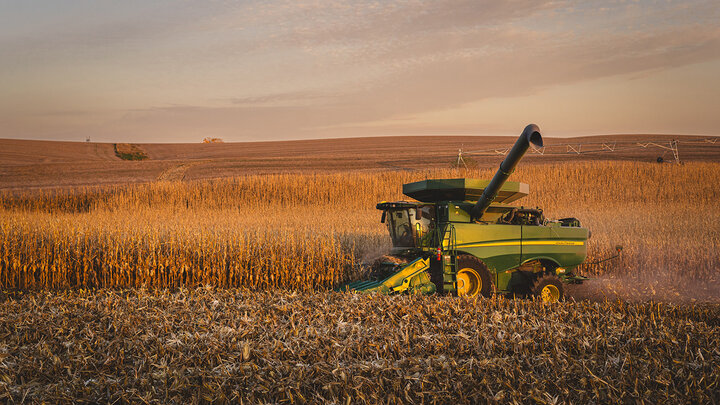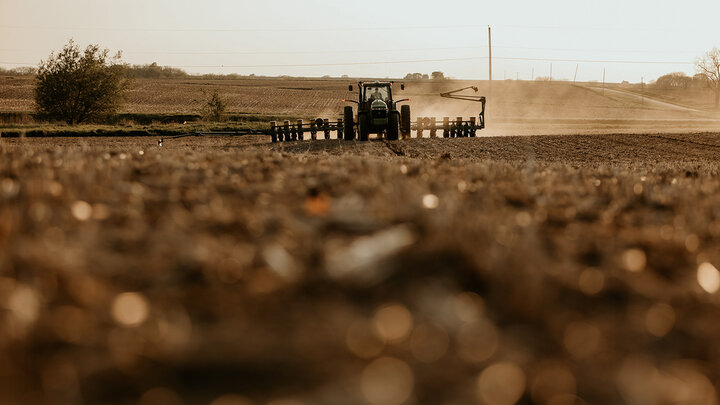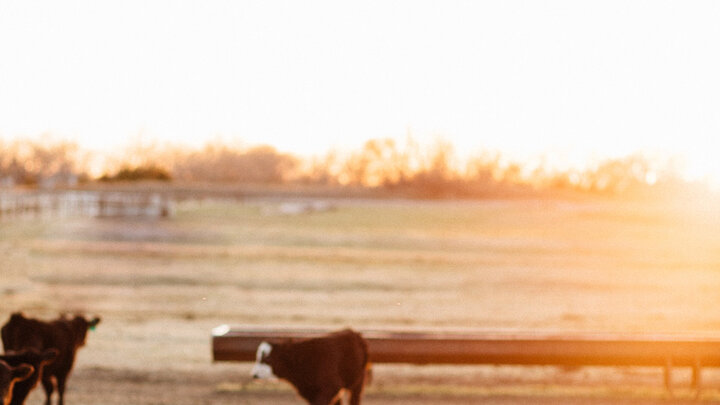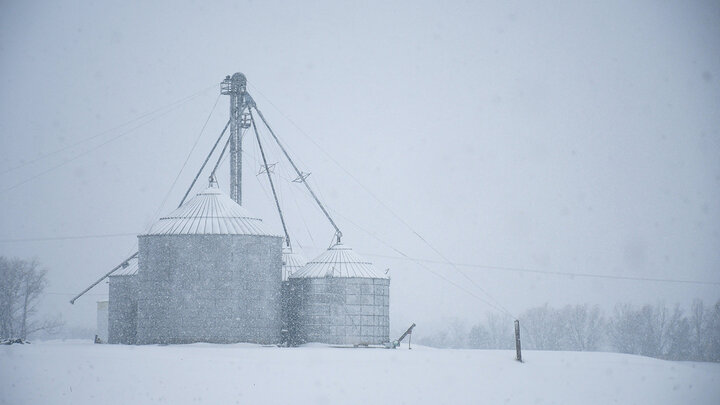At a Glance
- A 14-year case study of a Gage County dryland corn–soybean farm found crop share leases outperformed cash rent in 12 of 14 years.
- Average landowner income under a 60/40 crop share totaled about $1,951 per acre, compared to $1,545 under cash rent.
- Crop share offers higher long-term potential returns but greater year-to-year risk and management involvement.
- Cash rent provides predictable income and lower risk, appealing to absentee or risk-averse landowners.
This article was first published as part of the Department of Agricultural Economics's "Cornhusker Economics" series on Oct. 15, 2025.
A Case Study from Gage County (Dryland, Corn–Soybean Rotation, No-Till)
If you have recently inherited or purchased farmland in Nebraska, one of your first questions may be: How should I lease it? Two of the most common arrangements are cash rent and crop share. Each option comes with its own advantages and risks. More information on the difference between crop share and cash rental leases can be found here: UNL Extension — Considerations for Leasing: Cash Rent vs. Crop Share
This article presents a case study of a dryland farm in Gage County, Nebraska, managed under a corn–soybean rotation with no-till practices. Entire fields may be planted to a single crop in one year and switched to the other crop the following year, or large fields may be divided between both crops and then alternated annually. Using 14 years of local data, we compare landowner returns under a 60/40 crop share lease versus typical-for-the-region, cash rent rates. Elements in the leases presented here are intended to highlight the essence of the lease. Leases are highly customizable to specific conditions faced by each landlord and tenant.
The results show how dramatically the choice of lease structure can affect average income over time and variations in yearly rental income. For the landlord, the decision boils down to a guaranteed rental payment, cash rent, or a variable rental share where income is based upon yearly yields and prices.
Understanding the Basics
Before diving into the numbers, let’s define some key terms new landowners should know:
- Price: Market Year Average (MYA) is the official national average price received by farmers over the marketing year, published by USDA NASS. It accounts for all sales across the country and is used in federal farm programs. In this study, the MYA price is assumed to be the price at which grain is sold. Under a crop-share lease, both the landowner and tenant market their respective shares of the grain. In practice, prices will vary depending on sale dates and seasonal market conditions
- Yield: County yields are reported annually by the USDA’s National Agricultural Statistics Service (NASS). Prior to 2017, yields were published separately for irrigated and non-irrigated acres. Since then, NASS has combined irrigated and dryland yields, which may overstate expected production for dryland-only farms. For this study, county yields are used as the assumed yield measure. Actual yields within a county can vary widely due to differences in location, weather, soil quality, and other conditions. A farm’s Actual Production History (APH) generally provides a more accurate reflection of its individual productivity.
- Crop Share Lease: In this case, a 60/40 arrangement. The tenant keeps 60% of the crop and pays 60% of the yield-enhancing expenses (fertilizer, herbicide during the growing season, insecticide, fungicide, and application costs) in addition to other production costs such as seed, labor, equipment, crop insurance, and other expenses. The landowner receives 40% of the crop and pays 40% of the yield-enhancing expenses in addition to the fixed costs of property and income taxes, liability insurance, and possibly crop insurance. Input costs in this analysis come from the University of Nebraska–Lincoln (UNL) enterprise budgets for each year for a no-till operation with a corn and soybean rotation.
- Cash Rent Lease: A fixed, per-acre rental rate, regardless of yield or market price. This arrangement offers stability for landowners, but it does not change when commodity prices or yields rise or fall. Yearly non-irrigated cash rent values are reported from USDA-NASS.
- Government Payments: Many farms are enrolled in federal commodity support programs such as Agriculture Risk Coverage (ARC) or Price Loss Coverage (PLC). A more complete analysis of farm returns would incorporate average government payments, which can materially affect the income of both landowners and operators. Under crop-share leases, landowners are entitled to their proportionate share of these payments, for this example 40%. Payments are generally issued the year following production, creating a lag between farm activity and program benefits.
- Crop Insurance: Under crop-share leases, landowners may choose to purchase crop insurance, which provides financial protection against yield or revenue losses caused by natural perils such as drought, hail, or price declines. Policies are typically based on a farm’s Actual Production History (APH), with coverage levels and policy types selected according to risk preferences. Crop insurance was not looked at in this study.
Case Study Approach and Justification
To evaluate both lease types, we take a historical approach from 2012 to 2025. Our approach encompasses the drought of 2012, as well as high-yield years of 2017. Our approach identifies a long-run return to crop share as the crop share lease will vary year-to-year due to yearly variables. In practice, creating a share agreement will entail a forward-looking view. Next year's prices and yields are both unknown. According to the historical perspective, the lowest share was $109.57 in 2012, while the highest share was $356.81 in 2021. Share rental agreements come with a higher risk than cash rental agreements. Cash rent agreements have increased over time from $118 in 2012 to $168 in 2025. Cash rental agreements will continue to increase over time.
Case Study Data
- Corn Returns under Crop Share: Table 1 shows how landowner profits were calculated under crop share for corn acres: MYA price × landowner share of yield, minus the landowner’s share of expenses.
- Soybeans Returns under Crop Share: Table 2 shows how landowner profits were calculated under crop share for soybean acres: MYA price × landowner share of yield, minus the landowner’s share of expenses.
- Finally, landowner profits under crop share (corn, soybeans, and a 50/50 mix) were compared with USDA NASS non-irrigated cash rent for Gage County in Table 3.
| Table 1: Crop Share on Corn Acres (Landowner Perspective) | |||||||
Year | MYA Price ($/bu) | County Yield (bu/ac) | Landowner 40% Share (bu/ac) | Landowner Crop Sales ($/ac) | Total Shared Input Costs ($/ac) | Landowner 40% Share ($/ac) | Landowner Profit ($/ac) |
*2025 | $4.15 | 160 | 64.00 | $265.60 | $173.76 | $69.50 | $196.10 |
2024 | $4.35 | 166 | 66.40 | $288.84 | $176.15 | $70.46 | $218.38 |
2023 | $4.55 | 164.5 | 65.80 | $299.39 | $221.65 | $88.66 | $210.73 |
2022 | $6.54 | 133.8 | 53.52 | $350.02 | $159.36 | $63.74 | $286.28 |
2021 | $6.00 | 167.5 | 67.00 | $402.00 | $113.00 | $45.20 | $356.80 |
2020 | $4.53 | 162.5 | 65.00 | $294.45 | $117.37 | $46.95 | $247.50 |
2019 | $3.56 | 159.1 | 63.64 | $226.56 | $114.36 | $45.74 | $180.81 |
2018 | $3.61 | 172.7 | 69.08 | $249.38 | $98.90 | $39.56 | $209.82 |
2017 | $3.36 | 151.7 | 60.68 | $203.88 | $125.08 | $50.03 | $153.85 |
2016 | $3.36 | 125.2 | 50.08 | $168.27 | $134.09 | $53.64 | $114.63 |
2015 | $3.61 | 142.4 | 56.96 | $205.63 | $116.36 | $46.54 | $159.08 |
2014 | $3.70 | 158.7 | 63.48 | $234.88 | $117.19 | $46.88 | $188.00 |
2013 | $4.46 | 134.2 | 53.68 | $239.41 | $119.96 | $47.98 | $191.43 |
2012 | $6.89 | 58 | 23.20 | $159.85 | $125.70 | $50.28 | $109.57 |
| *2025 Price and Yield are estimates | |||||||
| Table 2: Crop Share on Soybean Acres (Landowner Perspective) | |||||||
MYA Price ($/bu) | County Yield (bu/ac) | Landowner 40% Share (bu/ac) | Landowner Crop Sales ($/ac) | Total Shared Input Costs ($/ac) | Landowner 40% Share ($/ac) | Landowner Profit ($/ac) | |
*2025 | $9.72 | 50 | 20 | $194.40 | $94.32 | $37.73 | $156.67 |
2024 | $9.95 | 41.1 | 16.44 | $163.58 | $97.47 | $38.99 | $124.59 |
2023 | $12.40 | 45.4 | 18.16 | $225.18 | $107.51 | $43.00 | $182.18 |
2022 | $14.20 | 36.5 | 14.6 | $207.32 | $106.08 | $42.43 | $164.89 |
2021 | $13.30 | 51.2 | 20.48 | $272.38 | $85.71 | $34.28 | $238.10 |
2020 | $10.80 | 48.2 | 19.28 | $208.22 | $88.25 | $35.30 | $172.92 |
2019 | $8.57 | 56 | 22.4 | $191.97 | $45.28 | $18.11 | $173.86 |
2018 | $8.48 | 51.1 | 20.44 | $173.33 | $42.30 | $16.92 | $156.41 |
2017 | $9.33 | 47.5 | 19 | $177.27 | $20.43 | $8.17 | $169.10 |
2016 | $9.47 | 53.2 | 21.28 | $201.52 | $21.07 | $8.43 | $193.09 |
2015 | $8.95 | 46.8 | 18.72 | $167.54 | $17.11 | $6.84 | $160.70 |
2014 | $10.10 | 47.8 | 19.12 | $193.11 | $20.94 | $8.38 | $184.74 |
2013 | $13.00 | 52 | 20.8 | $270.40 | $16.91 | $6.76 | $263.64 |
2012 | $14.40 | 32.6 | 13.04 | $187.78 | $15.56 | $6.22 | $181.55 |
| *2025 Price and Yield are estimates | |||||||
| Table 3: Crop Share & Cash Rent Comparison | ||||
| Landowner Profit (Corn Only) ($/ac) | Landowner Profit (Soybean Only) ($/ac) | Landowner Profit (Half Corn/ Half Soybeans) ($/ac) | USDA NASS Non-Irrigated Cash Rent* ($/ac) |
| 2025 | $196.10 | $156.67 | $176.38 | $168.00 |
| 2024 | $218.38 | $124.59 | $171.49 | $174.00 |
| 2023 | $210.73 | $182.18 | $196.46 | $171.00 |
| 2022 | $286.28 | $164.89 | $225.58 | $163.00 |
| 2021 | $356.80 | $238.10 | $297.45 | $155.00 |
| 2020 | $247.50 | $172.92 | $210.21 | $146.00 |
| 2019 | $180.81 | $173.86 | $177.34 | $152.00 |
| 2018 | $209.82 | $156.41 | $183.12 | $155.00 |
| 2017 | $153.85 | $169.10 | $161.48 | $155.00 |
| 2016 | $114.63 | $193.09 | $153.86 | $156.00 |
| 2015 | $159.08 | $160.70 | $159.89 | $150.00 |
| 2014 | $188.00 | $184.74 | $186.37 | $142.00 |
| 2013 | $191.43 | $263.64 | $227.53 | $130.00 |
| 2012 | $109.57 | $181.55 | $145.56 | $118.00 |
Total | $1,951.75 | $1,545.00 | ||
| *USDA NASS not data available for rental rates in 2018 & 2015 | ||||
Analysis
USDA NASS non-irrigated cash rental rates provided higher returns to landowners than crop-share arrangements in select years (2024 and 2016). By contrast, crop-share leases produced greater income in 12 out of the 14 years. Evaluated over the entire 14-year study period, cash rent generated a cumulative return of $1,545 per acre, while crop share averaged $1,951.75 per acre. These results highlight the variability between leasing structures and suggest that crop share has the potential to deliver stronger long-term returns. All comparisons are presented prior to accounting for government program payments or crop insurance indemnities, which could further affect profitability outcomes for both landowners and tenants.
What This Means for Landowners
Crop Share Leases
- Higher upside in strong price, yield, and low-cost years (e.g., 2021).
- Landowners share in both risk and reward, leading to large deviations in yearly returns.
- Requires more involvement, communication, and trust with the tenant.
Cash Rent Leases
- Lower but stable returns, regardless of price, yield, and cost outcomes.
- Landowners avoid risk but give up the chance for big years.
- Easier to manage, especially for absentee or risk-averse owners.
Over the 10-year span, crop share outperformed cash rent by 15–20% on average, though with much more volatility. The right choice depends on your goals:
- If you want predictability and simplicity, cash rent may be best.
- If you are comfortable with risk in yearly farm income and want the chance for higher returns, crop share could be more profitable over time.
The decision should also reflect your financial position. Crop-share leases should only be pursued if you are financially able to pay in-season expenses, effectively market your share of the grain, and withstand the risks of lower-income years.
Limitations to Keep in Mind
- County averages include irrigated acres; dryland-only farms often yield less.
- No crop insurance is factored in, which could significantly impact outcomes in drought years.
- Only yield-enhancing inputs were shared; seed, machinery, labor, and overhead costs remain with the tenant.
- Prices and expenses are estimates based on MYA and UNL budgets and will differ from individual farms.
- Government payments are excluded, but in practice, they can supplement income significantly.
Final Thoughts
Owning farmland represents both a financial investment and a vital part of Nebraska’s agricultural legacy. For new landowners, selecting the right lease arrangement is one of the most critical decisions to make. By understanding the mechanics of crop share and cash rent, and by reviewing local case studies like this one, landowners can align their choices with their risk tolerance, income goals, and long-term vision. The lease type should reflect the landlord’s financial position and the degree of management they are prepared to undertake.
Cash rent offers the security of steady, predictable income and immediate liquidity. In contrast, crop share agreements require more active involvement and the capacity to handle fluctuations in earnings. For those who do not want the full responsibility of crop share but also prefer not to enter a cash rental agreement, working with a professional land manager can provide a balanced alternative.
If landowners want to ensure their farmland is passed down from generation to generation, it is equally important to educate heirs on how to manage land ownership effectively. Preparing the next generation helps preserve both the financial value and the heritage of the land.
Results to the lease values used in our study are specific to the location. Lease values and outcomes will vary depending upon location.
Nebraska Crop Share Survey:
To better capture leasing practices, the Center for Agricultural Profitability at the University of Nebraska–Lincoln is conducting a statewide survey of crop share arrangements. The data collected will help provide agricultural producers, landowners, and professionals with valuable insight into current trends and cost-sharing practices in different regions of the state.
If you are involved in a crop share lease, whether as a landlord or a tenant, we invite you to participate. The survey asks about lease structure, shared expenses, and other common terms. Your anonymous responses will support the development of educational resources and tools to aid lease negotiations and farm planning.
The survey takes just a few minutes to complete and is available at: https://go.unl.edu/2025cropshare
Sources:
University of Nebraska Department of Economics. (Various Years). Center for Agricultural Profitability. Retrieved from: https://cap.unl.edu/cropbudgets/archive/
USDA-NASS. (Various Years). Census of Agriculture. Retrieved from: https://quickstats.nass.usda.gov




